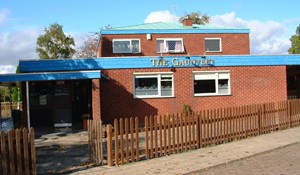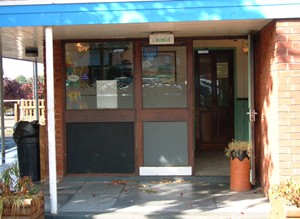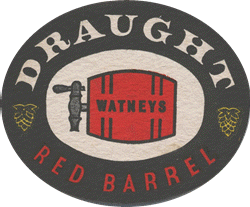Watneys Pubs in the 50s, 60s and 70s

Watneys, like any commercial organisation, both reacted to and attempted to lead the market. In building new public houses and refitting old ones, Watneys were very much in tune with the times. Sometimes they were innovative, with developments such as the Bird's Nest music bars and at other times plumbed the depths of bad taste with some ghastly themed pubs.
New towns, new pubs
Many new pubs were built in the 50s and increasingly in the 60s. As late as 1954 it was still difficult to get permission to build new public houses, but as restrictions were lifted and austerity gave way to "Never had it so good" new pubs began to appear. The planners of the new towns were thoughtful enough to allow the building of pubs and other recreation facilities and new housing estates often were provided with a modern pub.
At Stevenage, Watneys opened the Long Ship which occupied the ground floor of the town's tallest office block. A Viking theme was chosen and a mural outside depicted Vikings returning to their homeland after a raid. Inside a Danish theme was chosen; the Danish Lounge and Grill Room seemed tastefully furnished in fashionable Danish furniture. However, Viking motifs decorated the walls of the Danish Lounge and the inevitable Viking Bar.
Watneys opened the Woodcutter at the innovative Scottish New Town, Cumbernauld in 1970. Externally the pub blended in with its modern surroundings. Inside pine seemed to be the order of the day.
The style of the majority of public houses in the 50s and 60s followed prevailing architectural taste. Often the pub on an estate could display a considerable amount of style. Although, rarely the finest pieces of architecture, modern pubs often can typify the look of the 50s or 60s. Generally, they are not appreciated today and often subject to all kinds of unsympathetic alteration and more often demolition to make way for flats. This is a great shame since the sixties pub, represents the taste and style of that era, as well as the Victorian pub which is now revered.

Pubs in the 50s and 60s reflected the social structure of the day. They were rarely built without a public bar and a "posher" lounge or saloon bar, in which the beer was slightly more expensive. Watneys new public houses in the early to mid sixties usually had an off-licence attached. The Gauntlet in Kenilworth, my home town, was no exception. It was built to serve a new housing estate in the 60s. I have memories of cans of Party Seven being on prominent display in the off licence window. I had my first pint at the Gauntlet - lager, I'm afraid to say!
Themed pubs
The concept of themed pubs actually goes back many years. As early as 1948, Whitbread considered themed pubs and actually converted the Nags Head, Drury Lane to a theatre themed pub in 1950. In those days though, a theme simply meant a collection of memorabilia. On these terms you could even claim that the historic Bear, arguably Oxfords oldest pub, with its famous tie collection, was a themed pub.
However, by the end of the sixties, themed pub became a complete fantasy world. Rather than a collection of objects that the customers could choose to ignore, the theme became a large part of the drinking experience. Customers of the Ushers (part of the Watney Mann empire) Half Moon at Tiverton, could pretend they had chosen to spend their holiday, or evening out, in Hawaii, rather than rural Devon!
The customers entered via a fake rock cavern. Special effects such as rocks, waterfalls and palm trees greeted them. The interior was furnished with bamboo furniture, with rattan covered walls and a split ceiling covered with bamboo that gave customers glimpses of a Polynesian sky! This kind of fantasy seems odd in Tiverton, but it was not an uncommon theme in the 60s. Some Butlins Camps had Hawaiian Bars.
Another common fantasy was the age of chivalry. Modern lighting concealed in fake medieval armour was common, as were displays of armour and dining rooms designed to resemble medieval banqueting halls. Esso even kitted out a service station in this dcor. Watneys often used the antiquity of an old house as an excuse to do the same. They also built brand new pubs and gave them a nautical, Viking or Wild West theme. Often some spurious reason for the choice of a particular period was given. It was rarely appropriate to the pub or location.
In Coventry, a new house, "The Jolly Frenchman", had a Parisian restaurant decorated with French posters and Martini advertisements, but the crowning glory was a fake Arc de Triomphe. In Londons theatre land, the interior of an old Victorian pub, the Carnbourn, was ripped out without a thought to its history. The pub was renamed the Frigate and was turned into a three level mock up of an old time dockyard. There you could sit back and enjoy your drink whilst watching sailors kit bags being hoisted up and down to the sounds of squeaking pulleys!
[Perhaps today's breweries should consider this example before destroying pubs from the 50s, 60s and 70s!]
In 1970, in Tottenham, Watneys built a new pub called the Flower Pot on the site of an old pub of the same name. Here the name of the pub was so in tune with the spirit of the age, that a psychedelic theme was unavoidable. Perhaps the ultimate sixties trip into fantasy land, the Flower Pot, looked from the outside, like a bizarre, cartoon-style building, a pub on LSD! The customer entered via an elevated ramp and there were huge green vines snaking across the ceiling. Inside there were several bars on different levels. The decoration was, of course, flowers - giant coloured ones!. No need to take a trip - just go to the Flower Pot and have a pint of Red Barrel!
[Sadly the Flower Pot is no longer there. Such a period design would have stood little chance of surviving the many changes of fashion. It was demolished to make way for a supermarket.]
Birds' Nests

On 20 February 1968, Watneys Director Mr R H Combe and DJ Simon Dee opened a new pub in Twickenham, The Birds Nest. It was much more than a new pub. The Birds Nest represented a new concept in entertainment. Watneys combined a pub with a discotheque and an innovative system of telephone tables where customers could dial for food and drink. Inside a gay fairground type dcor was combined with an ultra modern stainless steel dance floor.
This Birds Nest was the first of several. The second was opened in the heart of swinging London as part of the Six Bells on the Kings Road in Chelsea. Two hundred and fifty people packed the launch party, which was attended by Simon Dee again, along with Cleo Laine and Johnny Dankworth. Here the theme was Bavarian. Watneys engaged German architect, Thomas Gehrig, who had designed the interiors of bars and clubs in Germany, Italy and the USA. The aim was to appeal to an international clientele.
Watneys continued to open more Birds Nest pubs. At the Green Man in Muswell Hill, a billiard room was converted by giving it a plush, nightclub style interior. Yet another one was opened in Waterloo, with Simon Dee becoming a regular at the launches.
With the Birds Nests pubs, Watneys had created a new style of venue that appealed to a new generation.
Schooner Inns
Top of the Watneys pub chain were the Schooner Inns. These were a new concept in drinking places that aimed to have a wider appeal beyond the traditional pub drinker. They usually had restaurants and the standard was consistent. You could drive anywhere in the country and know what to expect from a Schooner.
The first Schooner was the Crooked Billet in Staines, opened in November 1965. Schooners quickly became a national brand.
The Schooners were examples of sixties and seventies themed pubs at their best, or worst, depending on your point of view. Some of the conversions were understated others, such as the Frigate already mentioned, plumbed the depths of bad taste. The Boat and Bottle at Thorpe St Andrew, just outside Norwich, opened on 25 April 1969, was more restrained, although it is hard to believe that this is nearly forty years ago. The original house, the Thorpe Gardens Hotel famous for its tea garden in Victorian times, was extensively modernised and given a boating theme, with bars named "The Dropped Anchor" and "The Even Keel" and restaurants - "The Moorings" and "The Waterman". The décor apparently retained much of its historical character with oak beams, white walls and colourful curtain fabrics. The newly built parts of the building were pretty much late sixties in style, at least from the outside.
Schooners, together with Bernis, Trophy Taverns (Whitbread) and Toby Grills (Bass Charrington) became part of the family eating and drinking experience of the seventies. This style of pub/restaurant is still popular today, although all of these names have disappeared sometime in the eighties. Whitbreads Beefeater restaurants are the closest you get to it today.


Comments
Been trying to find any info about the publicans at the Masons Arms maddox st London from the 80,s .I worked there in 1979,80 and lost contact after I left , they where Rodney and Christine and they both came to manage the pub from Watneys she worked in the office and Rod was a delivery driver , I loved working there and they both treated me like family , Eddie the Scott newspaper seller was a regular ,I left and came back to Australia .
I remember my job intervue :have you worked in a pub before -NO, Can you change a keg and pour a beer - Maybe ,Whats your maths like -POOR , Do you drink -YES , Ok when can you start